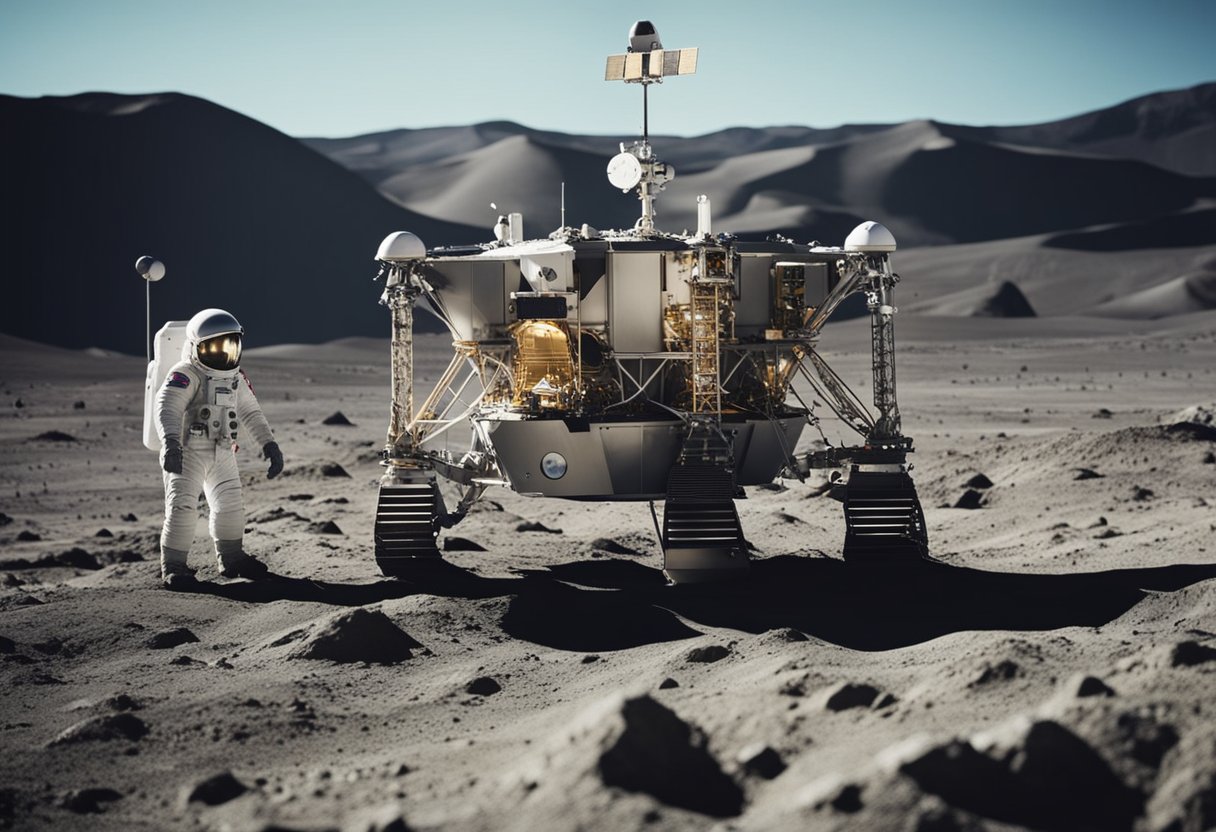
Lunar Landers History and Future – Lunar landers have been pivotal in our quest to understand and explore the Moon, from the historic Apollo missions to the cutting-edge technologies that promise to redefine future exploration. Our achievements in landing on the Moon have marked significant milestones in space exploration, showcasing remarkable human ingenuity and technological prowess. These landers have not only allowed us to set foot on extraterrestrial terrain but also facilitated groundbreaking scientific research that continues to inform our knowledge of the solar system.
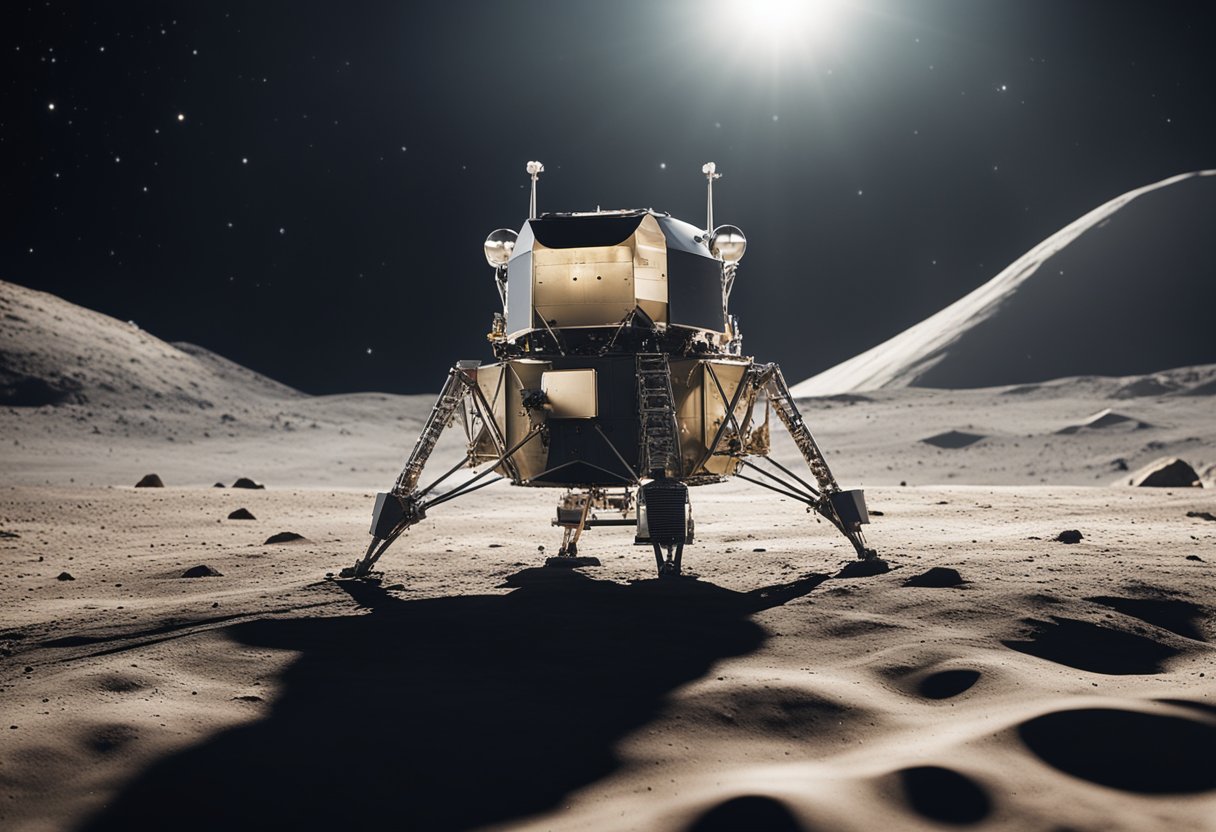
Looking forward, lunar landers are set to play a central role in missions that will expand our presence beyond Earth. With ambitions encapsulated by NASA’s Artemis program, which seeks to create sustainable exploration by the end of the decade, we are witnessing the dawn of a new era where commercial and international cooperation is becoming increasingly pivotal. As we anticipate the deployment of advanced rovers and landers, along with the establishment of the Gateway lunar outpost, the future of lunar exploration looks both challenging and exhilarating.
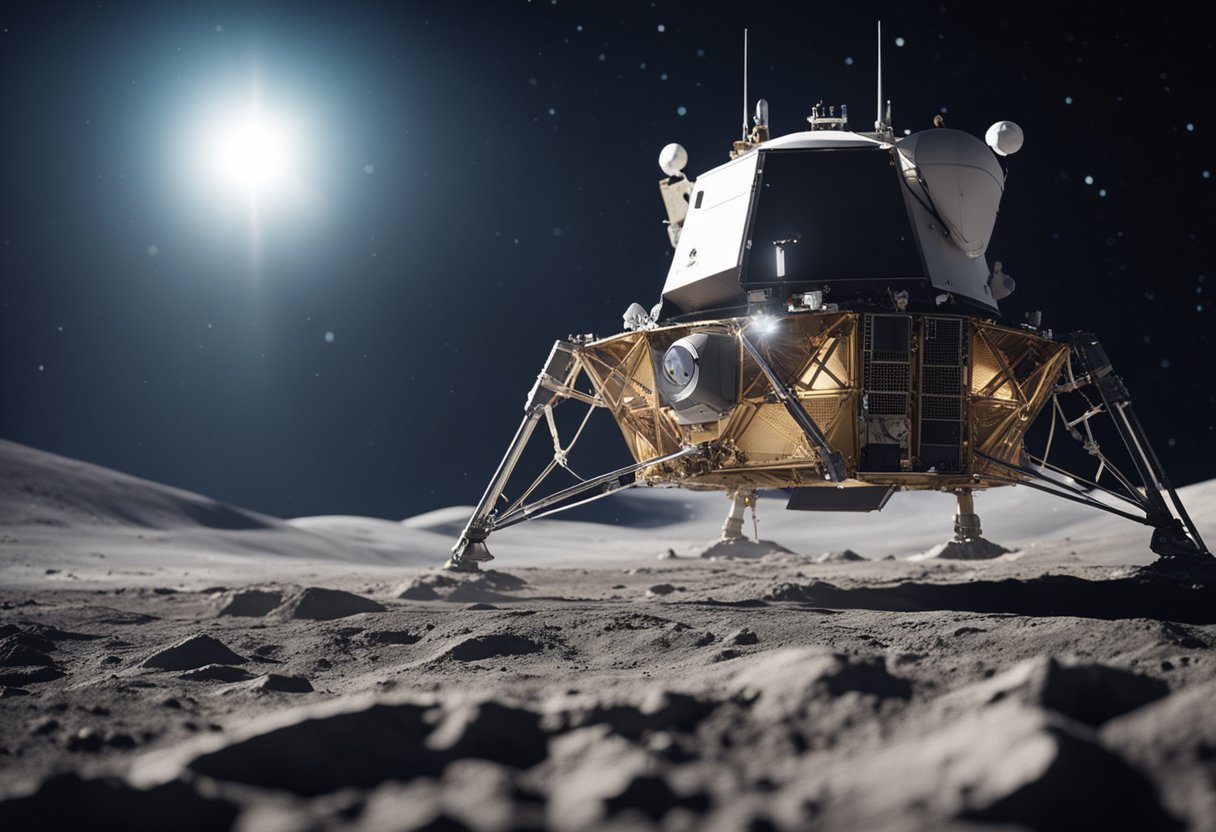
The beginning of lunar exploration marked a significant era in human history as nations competed for scientific and political advancements. We now witness a multitude of developments that trace back to the pioneering missions of the mid-20th century.
The first endeavours to the moon were marked by a series of unmanned missions. In 1959, Luna 1 was launched by the Soviet Union, heralding mankind’s first close approach to the lunar surface. Although it did not achieve a lunar landing, it provided a wealth of data, setting the stage for subsequent missions.
Just a few years later, in 1966, the Soviet’s Luna 9 succeeded as humanity’s first spacecraft to achieve a soft landing and transmit photographic data from the moon’s surface. This feat underscored the potential for future human presence on the moon.
Our fascination with the moon further intensified during the Cold War, as the Soviet Union and the United States found themselves locked in a fierce competition to demonstrate technological and ideological prowess.
The Apollo programme by the United States took a decisive turn in 1969 with the launch of Apollo 11. It was during this historic mission that astronaut Neil Armstrong became the first human to set foot on the lunar surface. His iconic phrase, “That’s one small step for man, one giant leap for mankind,” echoed across the globe, lifting the spirit of exploration to new heights.
The culmination of these missions has forged a path that may soon allow for space tourism beyond Earth’s orbit. SpaceVoyageVentures.com, a pioneer in this new frontier, captures the essence of these early triumphs while eyeing the horizon of making lunar experiences accessible to the public.
As we explore the advancements in lunar landers, we focus on two critical areas: robotics and automation, and materials and propulsion technology. These enhancements have significantly improved the functionality and capabilities of lunar exploration vehicles.
Robotics have come a long way since the Luna and Surveyor missions of the mid-20th century. The Lunokhod rovers, as the first remote-controlled vehicles to land on another celestial body, showcased the early potential of lunar robotics. Today, automation technology allows for more complex surface operations, such as autonomously navigating hazardous terrain and conducting intricate scientific experiments.
Automation has improved with sophisticated software that permits landers to execute precision landings. This is vital for touching down on specific areas of scientific interest or for rendezvous with other craft on the Moon’s surface. For example, recent European Space Agency initiatives have demonstrated significant progress in next-generation landing technology, enhancing landers’ accuracy and safety.
Innovations in materials used for lunar landers have increased their durability and ability to withstand the abrasive nature of the lunar regolith. Advanced composites and alloys now provide better resistance against micro-meteorites and sharp regolith particles, which can be detrimental to the integrity of lander components.
When it comes to propulsion, significant advancement has allowed for more efficient use of fuel and lower costs. Propulsion systems have evolved from the simple designs used in Surveyor 1 to more robust and reliable engines, capable of performing soft landings and, in some cases, allowing for ascent from the lunar surface, as we aim for the sustainability of lunar exploration missions.
By capitalising on these advancements in lunar exploration technology, we progress closer to our goals, which not only include scientific discovery but also the potential for early space tourism, as we broaden the scope of what’s achievable on the Moon.
The journey to the Moon has been marked by remarkable achievements and daunting challenges. Through a series of missions, humans have touched the lunar surface, unveiling the Moon’s secrets and setting the stage for future exploration.
Apollo 11 stands as a symbol of human ingenuity, achieving the first successful manned lunar landing in 1969 at the Sea of Tranquillity. This mission brought back to Earth striking images and invaluable lunar samples. Following this triumph, six more American Apollo missions would visit the Moon, but not every endeavour was smooth sailing. Apollo 13, known as a “successful failure,” suffered an in-space explosion but managed to circle the Moon and return its crew safely to Earth, showcasing resilience and quick-thinking in crisis management.
While the United States‘ Apollo missions are the most well-known, other nations ventured towards the Moon as well. The Soviet Union‘s uncrewed programme sent a series of Luna spacecraft, culminating in a number of firsts such as the first impact on the Moon with Luna 2 and the first soft landing with Luna 9.
More recently, lunar exploration has become a multinational endeavour with countries like China, India, and Israel launching their own missions. China’s Chang’e programme has achieved multiple soft landings on the Moon, including on the far side – a historic first. India’s Chandrayaan missions seek to delve deeper into lunar mysteries, although Chandrayaan-2’s lander Vikram was lost in 2019. Equally ambitious, Israel’s Beresheet lander, though unsuccessful in its first attempt, emphasises the growing global interest in lunar exploration.
For a glimpse into the future, where space tourism joins scientific exploration, visit SpaceVoyageVentures.com to learn about potential lunar tourism, including past missions and forthcoming opportunities.
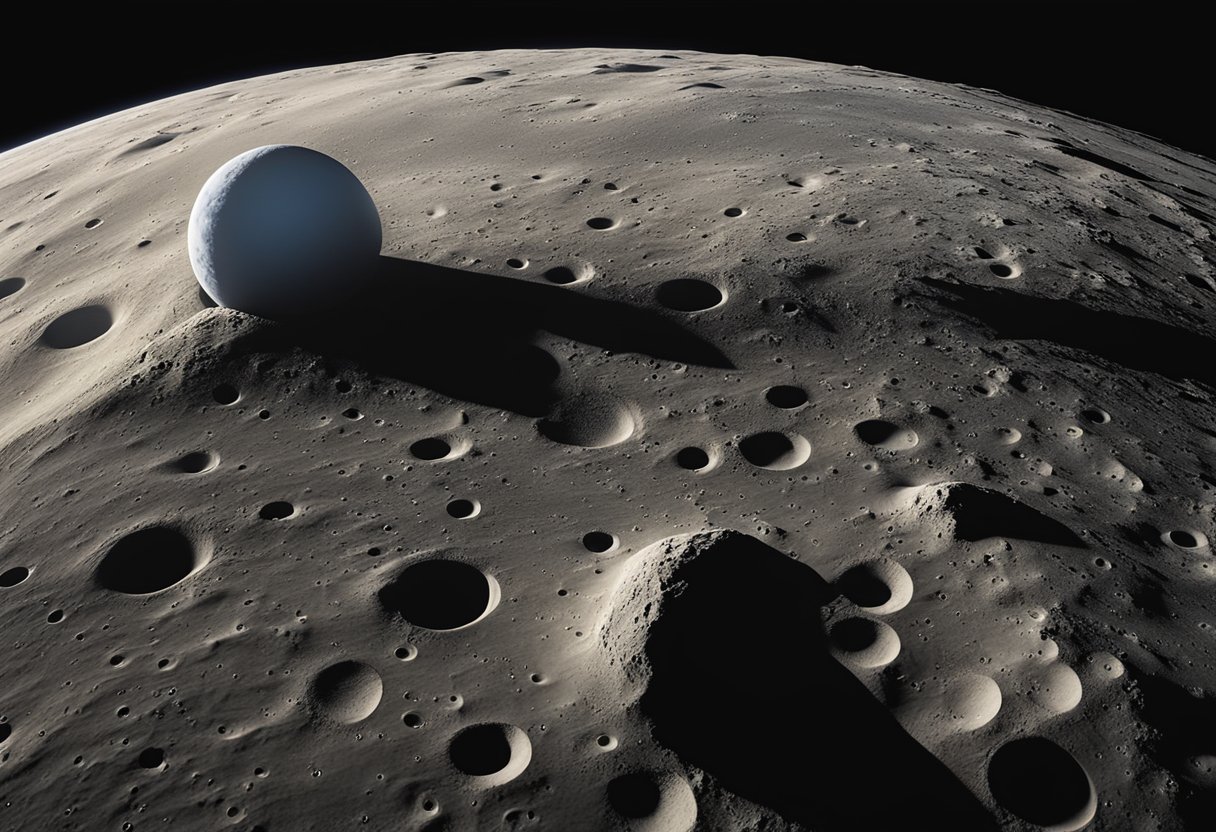
Before delving into the specifics of lunar orbiters, it is essential to understand their critical role. They are pivotal in gathering data about the Moon’s surface and environment, which aids in planning future missions and scientific studies.
Lunar orbiters were instrumental in mapping the Moon’s surface, primarily to identify safe landing sites for manned missions like Apollo. The Lunar Orbiter programme started in the 1960s, with orbiters photographing over 99% of the Moon’s surface. These early missions were not just about photography; orbiters also measured micrometeoroid impacts and radiation intensity, thereby increasing our understanding of the Moon’s environment significantly.
In recent years, lunar orbiters such as the Lunar Reconnaissance Orbiter (LRO) have expanded our knowledge about the Moon’s topology and potential resources. LRO, for example, has provided vital data on the Moon’s gravity field and surface temperatures while also detecting water ice at the lunar poles. The knowledge gained from modern orbiters has implications for proposed space tourism, like ventures envisaged by SpaceVoyageVentures.com.
The lack of a substantial lunar atmosphere means these orbiters can operate without aerodynamic drag, allowing for long-term data collection; this is crucial for monitoring changes over time and especially important for future orbiter designs targeting specific scientific objectives or scouting for potential human landing sites.
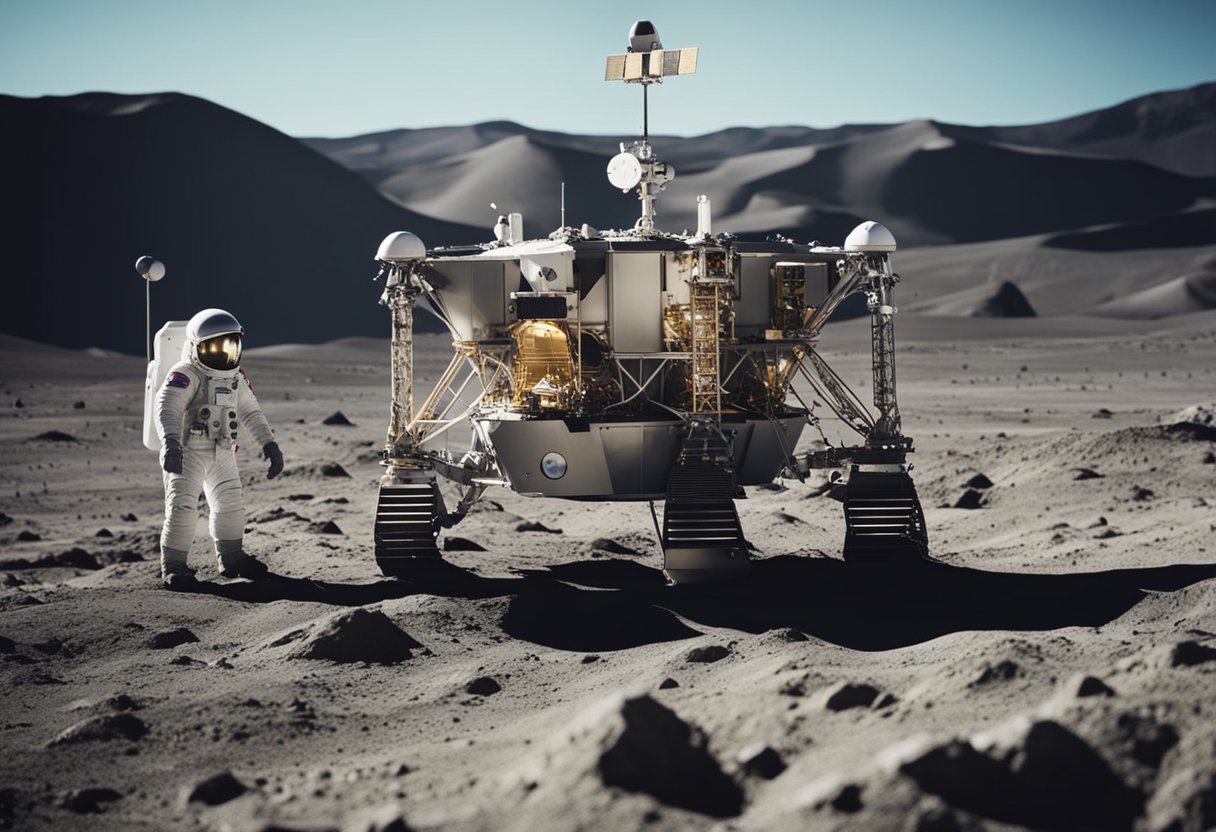
In this section, we explore how commercial entities and international collaboration are shaping the future of lunar exploration.
NASA’s Commercial Lunar Payload Services (CLPS) initiative marks a pivotal shift from traditional space exploration to a new era where the private sector plays an integral role. We have companies like Astrobotic and Intuitive Machines forging a path to the Moon by developing landers designed to transport scientific and commercial payloads. This initiative not only bolsters innovation but also expands access to lunar exploration for a range of stakeholders.
Astrobotic was selected to deliver payloads through CLPS, illustrating the critical role private companies play in NASA’s lunar exploration goals. Intuitive Machines, another commercial partner, is slated to conduct missions that will provide valuable data to inform future human lunar landings.
These efforts underscore the crucial part commercial partnerships will play in sustaining the lunar economy and ensuring continuous presence and exploration.
The field of lunar exploration has seen increased international cooperation, evidenced by the European Space Agency (ESA) contributions and joint missions with countries like Japan. Through such partnerships, technology and resources are shared, making lunar missions more feasible and cost-effective.
Japan has become a discerning collaborator through its space agency, contributing not only technology but also extensive research to international lunar exploration projects. The European Space Agency also brings a wealth of knowledge and resources, working closely with other nations to ensure the success of missions focused on expanding our presence on the Moon.
Collaborations like these highlight how pooling global expertise and capital can not only enhance the outcomes of lunar exploration but can also foster a sense of unity in pursuit of scientific advancement.
Commercial and international partnerships are evolving the landscape of lunar exploration. We are witnessing a convergence of interests where companies are crossing traditional boundaries and nations are coming together for the collective goal of unlocking the Moon’s potential.
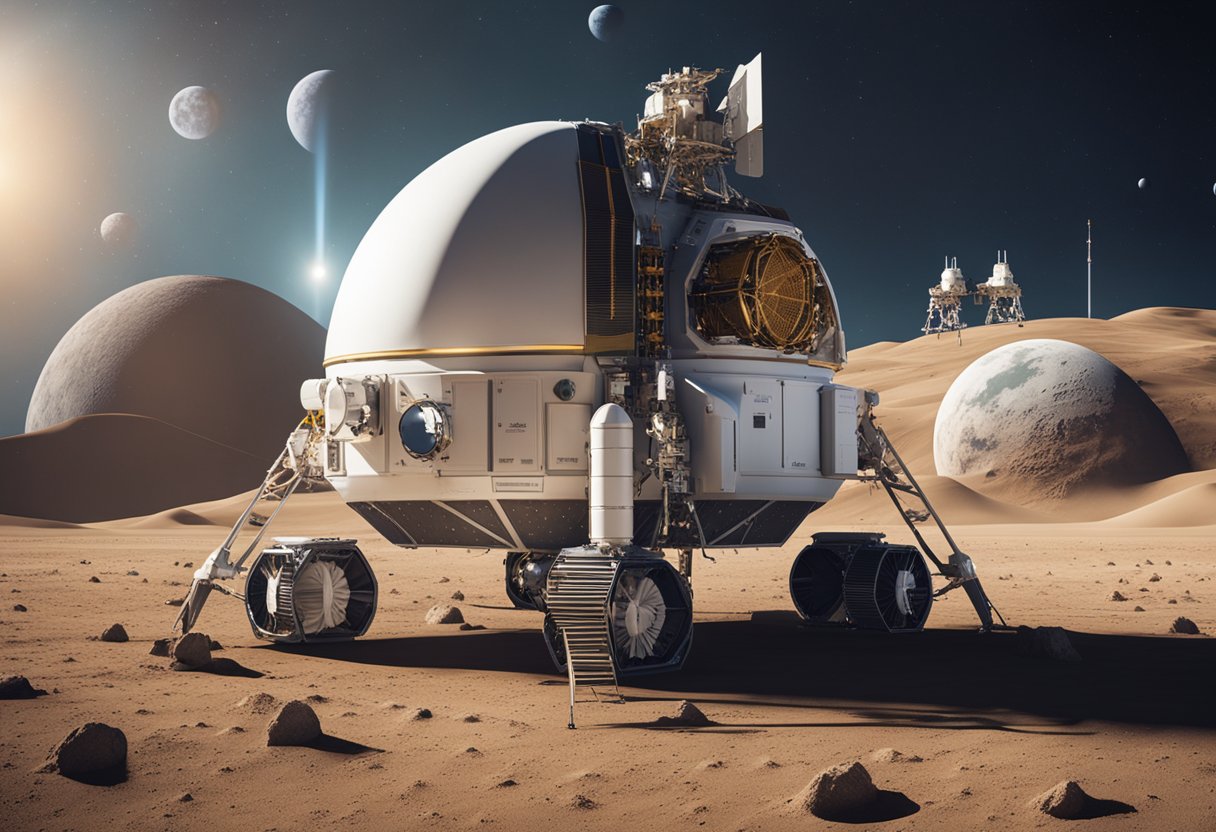
In our pursuit of lunar exploration, the Artemis Program stands as a pivotal endeavour by NASA to return humans to the Moon, complemented by the construction of the Gateway lunar outpost in orbit.
The Artemis Program represents our collective efforts to conduct a series of missions to the lunar surface and its orbit. The objectives are multifaceted—a demonstration of new technologies, strategies for long-term extraterrestrial living, and a solid foundation for future Mars expeditions. Underscored by collective anticipation, Congress has provided support for Artemis, understanding its role in propelling our spacefaring aspirations.
Situated in the lunar orbit, the Gateway is instrumental for our sustainable presence on the Moon. This small, human-tended space station serves as a multifunctional hub for science, exploration, and technology demonstrations. It will enable a more robust system for lunar lander docking and extend our ability to remotely operate rovers and other instruments on the lunar surface. As we construct the Gateway, our capabilities to explore and utilise the lunar domain will grow exponentially, assuring NASA’s leadership in space exploration.
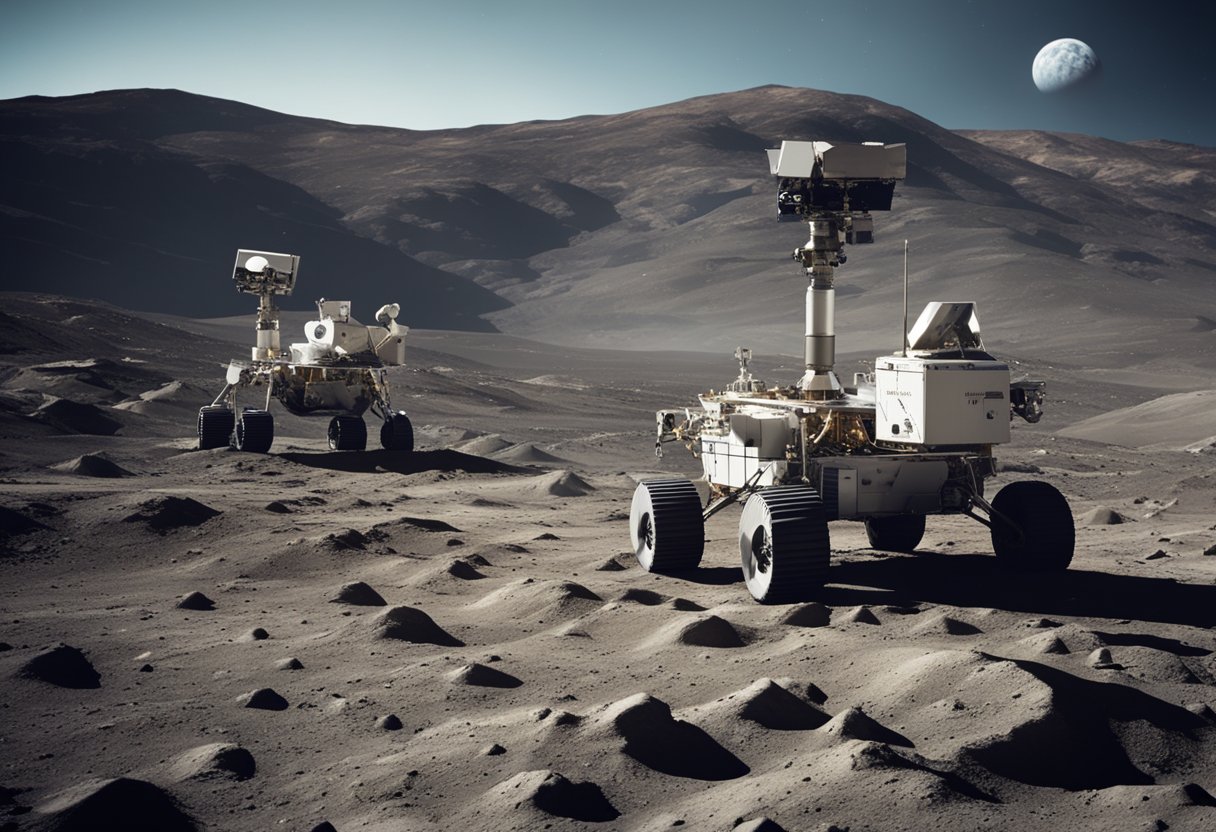
In charting the progress of lunar exploration, we see a marked evolution in both the complexity and capability of rovers and landers. These advancements are not just milestones in space technology but stepping stones towards a future where the moon plays a crucial role in our space endeavant.
Since the days of the Apollo missions, lunar rovers have been instrumental in extending the range of astronauts on the lunar surface. The Lunar Roving Vehicle (LRV), used in Apollo 15, 16, and 17, allowed for greater mobility, enabling the collection of a wider range of samples and data. Fast forward to recent developments, NASA’s VIPER is a new breed of rover designed to prospect for water ice at the moon’s South Pole. Its capabilities signify a leap forward in our quest to understand the moon’s resources, which could be vital for sustained lunar presence.
The evolution of lunar landers reflects a shift from government-only endeavours to a new era of commercial partnerships. NASA’s Artemis programme is at the forefront, paving the way for humanity’s return to the moon. Utilising commercial landers, such as Astrobotic’s Peregrine and Intuitive Machines’ Nova-C, these partnerships enable a sustainable exploration model. The sister lander to Peregrine, Astrobotic’s Griffin lander, is poised to deliver VIPER to the lunar surface, showcasing the collaborative efforts in modern lunar exploration. These next-generation landers are not only crucial for advancing scientific knowledge but are also instrumental in the developing space tourism industry, as highlighted by resources like SpaceVoyageVentures.com.
Combining robotic precision with human ingenuity, these advancements represent our collective effort to expand humanity’s reach in the cosmos.
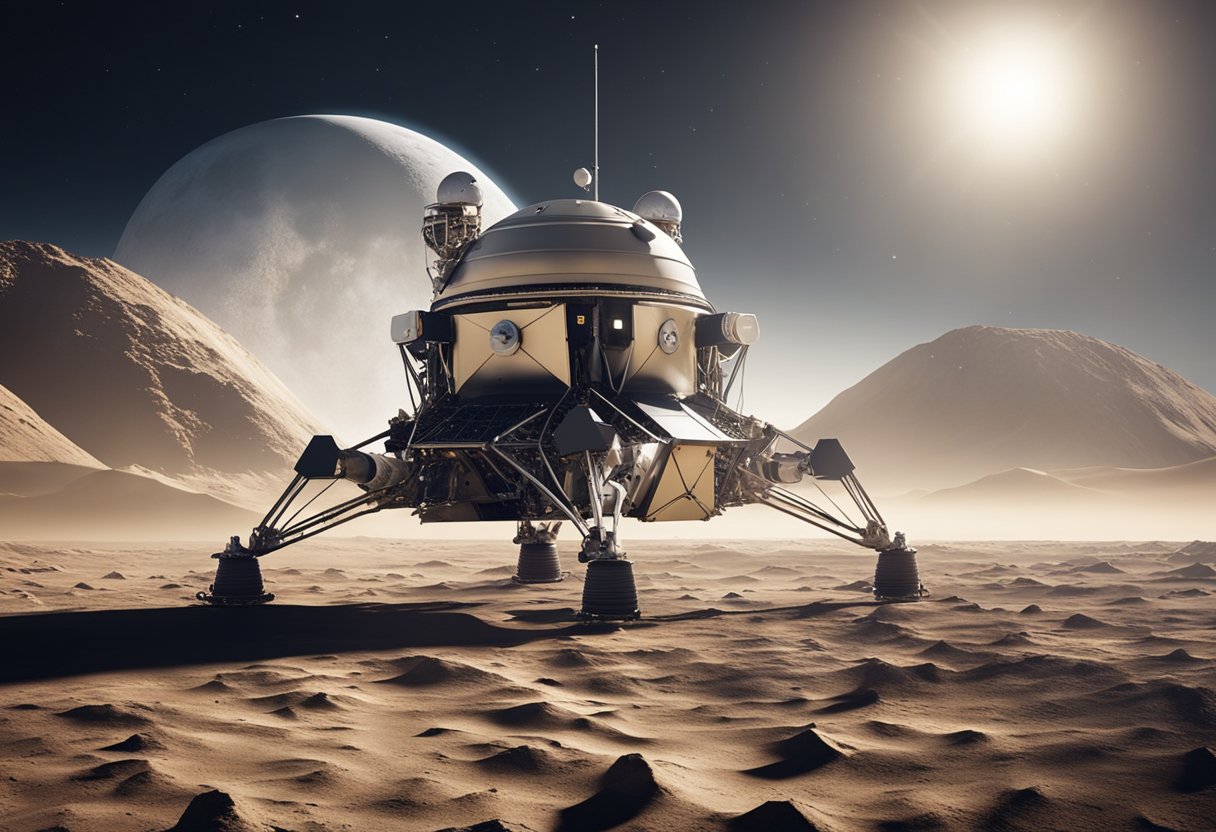
In the coming years, our ambitions for lunar exploration are set to transform the Moon into a hub of human activity and technological innovation.
Our objectives for maintaining a human presence on the Moon centre around the establishment of lunar bases, particularly at the lunar south pole. This area is of high interest due to the presence of water ice, which can be crucial for life support and as a resource for producing hydrogen for fuel. The success of crewed lunar landing missions is pivotal in achieving this, as they will pave the way for subsequent construction and long-term habitation projects.
The prospecting and utilisation of lunar resources is a top priority. The lunar south pole is rich in minerals and presents abundant opportunities for harvesting water ice and other volatiles. These resources not only support life but also have the potential to provide energy and raw materials for various processes. Efficient use of the Moon’s resources can significantly aid in reducing the cost of space exploration and establishing a sustainable presence beyond Earth.
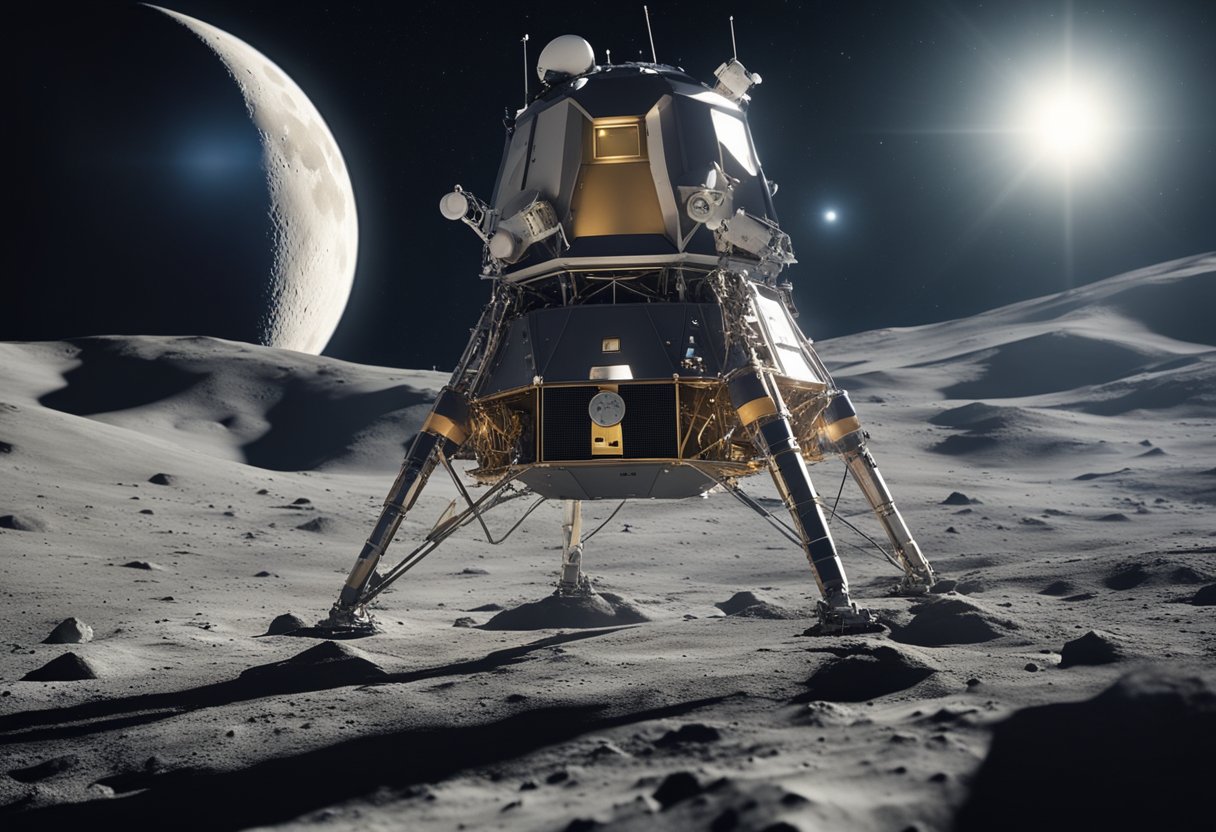
With the frontier of space beckoning us further, our commitment to pioneering technologies is the cornerstone of successful deep space missions. These innovations not only pave the path to distant celestial bodies but also ensure the safety and effectiveness of our journey.
We recognise the utmost importance of robust life support and habitat systems for long-duration space expeditions. Such systems are designed to maintain a stable environment within spacecraft, like the Orion spacecraft, which is critical for the survival of astronauts venturing beyond low-Earth orbit. One vital component is the Closed Loop Life Support System, which recycles air and water to sustain the crew for months or even years. Regenerative Environmental Control and Life Support Systems (ECLSS) are also pivotal, managing resources to provide clean air and water while minimising waste during missions.
Our pursuit of innovations in human spaceflight continues to break new ground. Advancements in propulsion, such as solar electric propulsion (SEP), are being researched and developed to expedite travel between celestial bodies. Furthermore, the use of autonomous navigation systems has shown great potential in enhancing the precision of landings on uncharted extraterrestrial terrains. For instance, technology that facilitated the SLIM lander’s precision moon landing is a significant step forward, allowing for more accurate touchdowns in future missions. Simultaneously, extensive efforts are underway to ensure these spacecraft can endure the harsh conditions of space, enabling science and technology experiments in the most remote environments.
These endeavours reflect our dedication to extending the realm of human exploration, propelled by science and innovation.
In the ambitious endeavour of lunar exploration, we face numerous challenges and controversies, ranging from political implications to intense commercial rivalry.
The course of lunar exploration is profoundly influenced by political and ethical issues. Bill Nelson, the NASA Administrator, plays a pivotal role in addressing international partnerships and collaborations. The Human Landing System programme, a part of the Artemis plan, which reintroduces humans to the Moon, has sparked debates. Questions about the utilisation of lunar resources and the preservation of historical sites add complexity to lunar expeditions.
The drive to the Moon has ignited fierce competition among American companies. The Commercial Lunar Payload Services (CLPS) has provided a platform for private firms to vie for NASA contracts. These opportunities have spurred innovation but also led to increased scrutiny over the allocation process and the viability of missions. Companies strive to prove their worth, not merely for pride but for substantial financial gains and a chance to be part of space tourism, as discussed on platforms like SpaceVoyageVentures.com.
Controversy surrounding commercial competitions centres on the fairness and transparency of contract awards, as well as concerns over intellectual property and market monopoly. The achievement of one company can signify setbacks for others, creating an environment of not just progress but also contention.
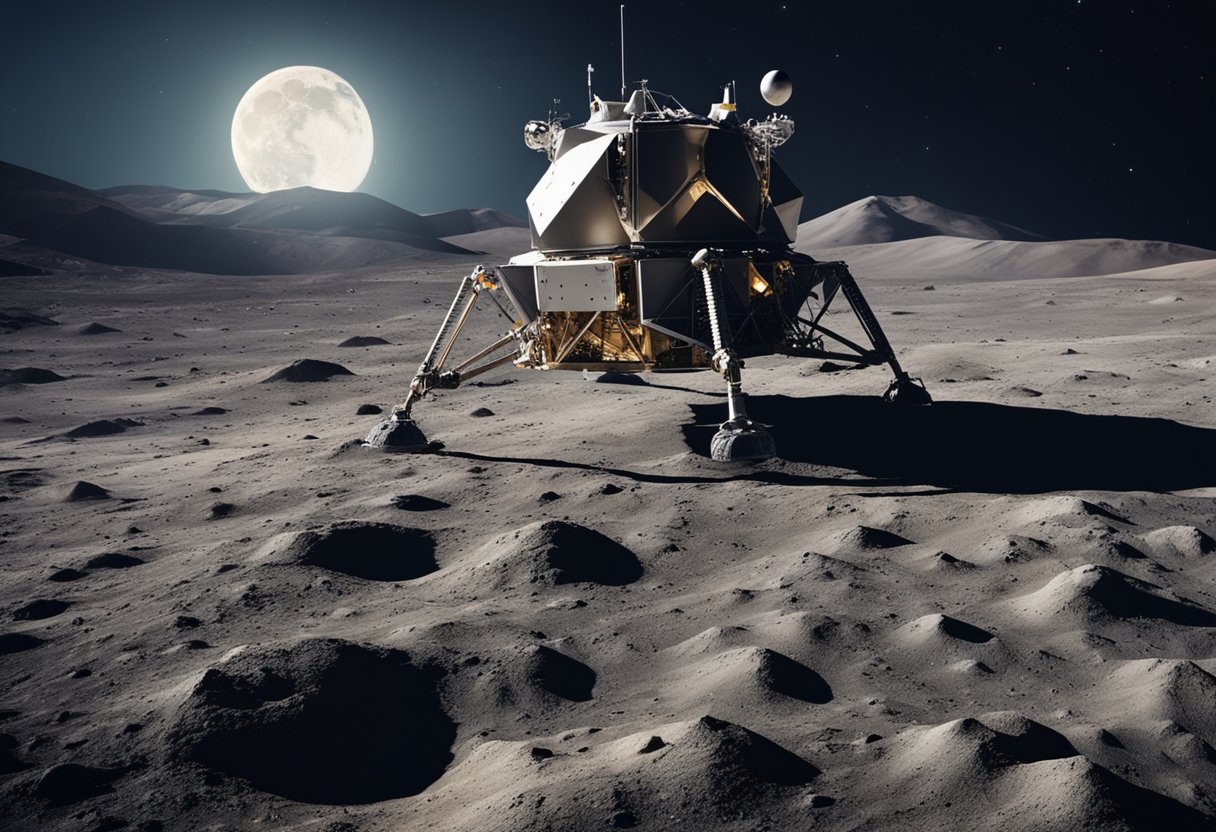
In our exploration of lunar landers, we aim to detail the significant advancements in their design and use, spanning from historic milestones to what the future holds for Moon exploration.
Key developments in lunar landings began with the historic Apollo 11 mission, which brought humans to the Moon for the first time. Since then, we’ve seen successful soft landings with robotic missions like China’s Chang’e 3, illustrating our capacity for remote exploration. For detailed insights into these milestones, reading about changing lunar exploration can be quite enlightening.
Progress in lunar lander technology includes advancements in propulsion, navigation, and materials, enabling us to land heavier payloads and provide life support for longer missions. The evolution also involves improved precision in landing technologies, allowing us to target scientifically significant sites with greater accuracy.
Major space agencies, such as NASA, continue to lead with programmes like Artemis, aiming to return astronauts to the lunar surface. Meanwhile, private companies are playing a growing role, with initiatives to develop commercial landers that will foster a sustainable presence on the Moon. To understand more about these efforts, consider how NASA’s plans and commercial endeavours are shaping future missions.
Future missions target a blend of scientific discovery and enabling a sustained human presence on the Moon. This includes looking for resources like water ice, testing new technologies for life support and habitat construction, and paving the way for longer-duration human expeditions.
Today’s lunar landers are being designed with modern technologies that reduce weight and improve reliability. Compared to the Apollo-era lunar module, contemporary designs incorporate advancements in materials and miniaturisation of electronics, along with modularity to support various mission types.
Success in future lunar exploration hinges on overcoming challenges such as extreme temperature variations, lunar dust, and the development of life support systems for longer stays. Reliable communication systems and sustainable power sources are also critical components that need to be advanced.